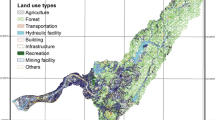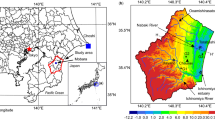Abstract
This study examined the Kaoping River basin, Taiwan, an area severely destroyed by Typhoon Morakot in 2009. Dynamically downscaled data were applied to simulate extreme typhoon precipitation events for facilitating future preparation efforts (2075–2099) under climate change conditions. Models were used to simulate possible impacts in upstream and downstream areas for basinwide disaster loss assessment purposes. The Transient Rainfall Infiltration and Grid-Based Regional Slope-Stability and FLO-2D models were applied to simulate slope-land disaster impacts and sediment volume in the upstream area. The sediment delivery ratio was used to calculate the valid sediment amount delivered downstream and the riverbed uplift altitude. SOBEK was used to build a flood impact model for the Kaoping River basin, and the model was used to simulate potential flooding caused by future extreme typhoon events. The Taiwan Typhoon Loss Assessment System established by the National Science and Technology Center for Disaster Reduction was used to evaluate the potential loss associated with extreme events. The property loss calculation included 32 land-use categories, including agriculture, forestry, fishery, and animal husbandry losses; industrial and commercial service losses; public building losses; and traffic and hydraulic facility losses. One of the Kaoping River basin townships, Daliao District, had the highest flood depth increase ratio (12.6%), and the losses were 1.5 times the original situation. This was much worse than were the losses suffered during Typhoon Morakot. These results also show that sediment delivered from the upstream areas had a significant influence on the downstream areas. This is a critical issue for future flood mitigation under climate change conditions.
















Similar content being viewed by others
References
Chen SC, Lai YC (1999) Estimating the sediment delivery ratio in rivers and watersheds. J Chin Soil Water Conserv 30(1):47–57
Chen C, Beardsley RC, Cowles G (2006) An unstructured grid, finite-volume coastal ocean model (FVCOM) system. Oceanography 19(1):78–89
Chen WF, Lee DE, Chen YC (2011) The sediment cleanness work for sustainable management- a case study of Tseng-Wen reservoir watershed. In: Chinese soil and water conservation society annual conference, Taipei, Taiwan
Chen YH, Tan CH, Chen MM, Su TW (2013) Estimation of rainfall threshold for regional shallow landslide in a watershed. J Chin Soil Water Conserv 44(1):87–96
FLO Engineering Inc (2006) FLO-2D users’ manual
Ho HC, Lin BS, Chang YL, Chi SY, Chien YD, Tsai MD, Fei LY (2013) Effectiveness assessment of hill slope conservation on Zheng-Wen reservoir after typhoon Morakot. J Sinotech 118:21–30
Hsu MH (1996) North embankment flooding and a flood forecast model for the Ba-Zhang River Basin (2). Research Program Report, National Science Council
Hsu SM, Chiou LB, Lin GF, Chao CH, Wen HY, Ku CY (2010) Applications of simulation technique on debris-flow hazard zone delineation: a case study in Hualien County, Taiwan. Nat Hazards Earth Syst Sci 10:535–545
Hsu H-H, Chou C, Wu Y-c, Lu M-M, Chen C-T, Chen Y-M (2011) Climate change in Taiwan: scientific report 2011 (Summary). National Science Council, Taipei, Taiwan, R.O.C
Huang JC, Kao SJ (2006) Optimal estimator for assessing landslide model performance. Hydrol Earth Syst 10:957–965
Ikeya HA (1998) A method of designation for area in danger of debris flow. Erosion and sediment transport in Pacific Rim Steeplands. Int Assoc Hydrol Sci Publ 132:576–588
Iverson RM (2000) Landslide triggering by rain infiltration. Water Resour Res 36(7):1897–1910
Ko TF, Yeh CT, Wu CH, Wang YM (2006) Identifying potential floods in low-lying urban areas and operating flood detention ponds. J Univ Sci Technol Beijing 28(S2):148–151
Lai YC (2011) Evaluation of sediment delivery ratio and completeness ratio of the reservoir watershed, Doctoral Dissertation, National Chung-Hsin University
Li HC, Kuo YL, Shaw D, Huang TH (2008) The household benefits assessment of the flood reduction plan in a flood-prone area: a case study of Sinwen, Chiayi, Taiwan. Agric Resour Econ 5(2):41–58
Li WS, Yeh KC, Lin CC, Hsieh CL, Wen CC, Yeh YL, Shie LS, Chen LG, Li SJ, Wang YW (2010) Exploration and analysis regarding the aftermath of typhoon Morakot research project report. National Science Council, Taipei City (NSC 98-2625-M-492 -010)
Li H-C, Chen Y-C, Guo M-J (2013) The development and application of Taiwan typhoon loss assessment system (TLAS). J Taiwan Agric Eng 59(4):42–55 (In Chinese)
Li H-C, Wei S-P, Cheng C-T, Liou J-J, Chan Y-M, Yeh K-C (2015) Applying risk analysis to disaster impact of extreme typhoon events under climate change. J Disaster Res 10(3):513–526
Liu KF, Huang MCh (2006) Numerical simulation of debris flow with application on hazard area mapping. Comput Geosci 10(2):221–240
Liu K-F, Li H-C, Hsu Y-C (2009) Debris flow hazard assessment with numerical simulation. Nat Hazards 49(1):137–161
Mizuta R, Yoshimura H, Murakami H, Matsueda M, Endo H, Ose T, Kamiguchi K, Hosaka M, Sugi M, Yukimoto S, Kusunoki S, Kitohj A (2012) Climate simulations using the improved MRI-AGCM with 20-km grid. J Meteor Soc Japan 90(A):235–260
O’brien JS, Julian PY, Fullerton WT (1993) Two-dimensional water flood and mudflow simulation. J Hydraul Eng 119(2):244–261
Quan Luna B, Blahut J, van Westen CJ, Sterlacchini S, van Asch TWJ, Akbas SO (2011) The application of numerical debris flow modelling for the generation of physical vulnerability curves. Nat Hazards Earth Syst Sci 11:2047–2060
Salciarini D, Godt JW, Savage WZ, Conversini P, Baum RL, Michael JA (2006) Modeling regional initiation of rainfallinduced shallow landslides in the eastern Umbria Regional of Central Italy. Landslides 3:181–194
Shih MW (2006) Simulation study on applying 2D inundation model for three drainage systems in Chang-Hua County. Master’s Thesis, Department of Soil and Water Conservation, National Chung Hsing University
Tang CY, Hsieh PC, Lin LL (2006) The application of FLO-2D and HEC-GeoRAS for simulating the flooding in Na-Hu Creek caused by typhoon Mindulle. J Soil Water Conserv 40(4):455–467
Vieira BC, Fernandes NF, Filho OA (2010) Shallow landslide prediction in the Serra do Mar, São Paulo, Brazil. Nat Hazards Earth Syst Sci 10:1829–1837
WL | Delft Hydraulics (2006) SOBEK software user’s manual. delft, the Netherlands
Wu CH, Chen SC, Chou HT (2011) Geomorphologic characteristics of catastrophic landslides during typhoon Morakot in the Kaoping Watershed, Taiwan. Eng Geol 123:13–21
Yen CL, Tsai YP, Chen LC, Hsu MS, Lin ML, Lo CH (1997) National disaster prevention technology program—plan report
Acknowledgements
The authors extend their deep appreciation to Dr. Akio Kitoh of the Japan Meteorological Research Institute for the provision of MRI data and to the anonymous reviewer for their helpful comments. This project was funded by the Taiwan National Science Council (MOST 103-2621-M-865-001).
Author information
Authors and Affiliations
Corresponding author
Rights and permissions
About this article
Cite this article
Li, HC., Wu, T., Wei, HP. et al. Basinwide disaster loss assessments under extreme climate scenarios: a case study of the Kaoping River basin. Nat Hazards 86, 1039–1058 (2017). https://doi.org/10.1007/s11069-016-2729-7
Received:
Accepted:
Published:
Issue Date:
DOI: https://doi.org/10.1007/s11069-016-2729-7




